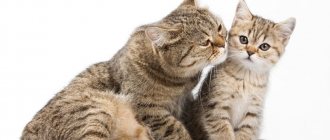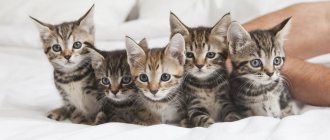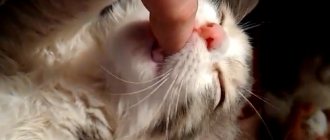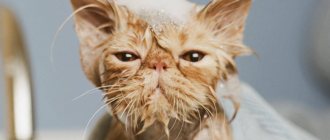Purring is a quiet and prolonged vibration emitted by some representatives of the cat family. Many people attribute healing properties to this ability. It is put on a par with the sound of rain, the crackle of a fire and other pleasant and relaxing sounds. Felinologists are still trying to figure out how and why cats purr, and ordinary people have long figured out which breeds are considered the most “talkative.”
Specifics of cats purring
For a long time, scientists could not figure out why cats purr, because they do not have a special organ responsible for this. And only recently it was possible to more or less understand why this still happens. In the process of purring, special parts of the brain are involved, which send impulses to the muscles and because of which the cats’ vocal cords begin to vibrate. The vibration is transmitted to the hyoid bones, which are located between the base of the skull and the root of the cat's tongue.
After the vibration is transmitted to the bones, it spreads throughout the body, causing this characteristic sound to be heard. Unlike meowing, cats can purr both while inhaling and exhaling, because the sound of meowing passes through the vocal cords as air passes through and is produced only when exhaling. Therefore, cats can purr both when they eat and when they fall asleep. And small kittens along with eating mother's milk.
But why then can't tigers or lions purr? Only small felines, wild and domestic cats are endowed with this function. The secret lies in the specifics of the production of purring in cats. Small species are endowed with thin hyoid bones that can vibrate. And large predators have bones covered with cartilage and vibration cannot be transmitted through them, but they can roar excellently, impressively and loudly.
According to some experts, purring has several types. These types differ in the range of sounds from 50 to 150 Hertz. One type of rumbling can be when a cat lets its owner know that it is hungry or to pay attention to it. This rumbling is usually loud and short-lived. But if the cat is already fed and caressed, then its purring will be quiet and long, and the volume will not exceed 60-70 Hertz.
Which other member of the cat family can purr?
Once you understand how cats purr, it is not so difficult to understand which of their wild relatives is capable of emitting similar sound vibrations. Large cats differ not only in the shape of the hyoid bone, but also in the elasticity of the ligaments. Only the group of small cats has the most flexibility: cheetahs, ocelots and lynxes; they can make purring sounds.
Despite physiology, there are exceptions. Purring large predators include snow leopards, pumas, clouded leopards and leopards. Given the structure of the larynx, their ability is a real mystery.
The main reasons why cats purr
There are many versions of why cats can purr and why, and here are the main ones:
- Thanksgiving. Purring, cats thank for food, warmth, stroking, affection. In these cases, a quiet purr is a clear sign of a satisfied cat.
- Relaxation. When cats feel calm, they purr. So, kittens, when they suck a cat’s milk, purr from calmness and tranquility. You can’t meow and eat at the same time, so they purr quietly.
- Expression of emotions. Some believe that a cat's purring is a kind of human singing. With the help of various intonations, sounds and vibrations, cats show their emotional state at the moment. Likewise, people, when they are puzzled by something or, on the contrary, relaxed, hum some song under their breath.
- Communication between kittens and mother. By purring, the kittens tell their mother that everything is fine with them, they are full and happy. This is especially important for wild cat breeds, since adults often leave babies alone when going hunting.
- Meeting other cats. When a cat meets another, it begins to purr, showing its greeting and friendliness. Strong males, when meeting weak ones, make it clear by purring that they will not attack them.
- Self-medication. During illness or stress, cats begin to purr to calm down and bring their body back to normal. The vibrations they produce improve blood circulation and improve metabolism. With the help of rumbling, a cat can warm up or calm down from fear. Then it is better not to disturb him and let him calm down on his own.
- Getting ready for bed. When cats are about to fall asleep, they may begin to purr softly. Measured vibration helps them calm down and relax before bed. Scientists have found that during purring it is impossible to listen to the lungs or heart, because the vibrations spread too strongly. This helps pets get a better night's sleep.
- Presence of hunting instinct. Cats can purr while watching a bird in the window or the rustling of a leaf on the lawn. This is how they show their interest in a moving object.
- Self-defense. Cats can purr loudly and belligerently when they sense danger for themselves or their offspring. In such cases, it is better not to touch them, because they can attack and scratch painfully.
- Fear. Feelings of strong fear can be caused by an exciting purr, which means that the cat asks not to touch it, because it is defenseless.
- The desire to receive something. When cats want a piece of tasty food or affection from their owner, they begin to purr. This often works on people and furries often get what they want.
- Presence of illness. By purring, cats can communicate about possible illnesses, and the purring is restless and loud. Just in case, it is better not to postpone a visit to the veterinarian.
Thus, cats can purr because of anything. But why they do this can only be understood by the most observant cat owners who carefully monitor the health and well-being of their pets.
Scientists' opinion
Zoologists believe that the occurrence of purring is primarily associated with motherhood. With this sound, the mother calms the babies, lets them know that she is nearby, and can also warn of danger.
In addition, researchers from the American Stanford Institute found that purring helps strengthen bones.
A pet's sedentary lifestyle, which spends most of the day sleeping, does not affect the health of the musculoskeletal system precisely because of this ability: vibration restores musculoskeletal activity.
Why do cats purr when petted?
In fact, human touches are irritating for a cat, but she may not always react with displeasure. It is clear that if you stroke your pet against the grain or when he is not in a good mood, then in this case the cat may twist its tail in displeasure or even scratch it. However, if you gently pet your pet when she wants it, she will most likely begin to purr with pleasure. Cats are very sensitive to the mood of the owner and see when he strokes lovingly, so they purr in response, expressing mutual love and trust.
Purring as a stress reliever
Veterinarians say that the process of purring helps a cat cope with pain. Vibration relieves tension from the muscles, from which blood flows to the brain, which helps to quickly calm the pet.
For example, cats purr especially intensely during childbirth. This helps them not only calm down, but also breathe correctly.
If the owner needs to provoke purring, it is recommended to stroke the area of the neck, belly, and back.
Purring as a means of communication for cats
Purring sounds help cats communicate with each other, warn about something or report. If a cat purrs quietly, this may mean that she has a friendly attitude, she is calm and friendly. A loud purr indicates the dominance of this cat over its relatives. This is how she shows a weaker opponent that there is no point in fighting with her and the weaker cat does not have to worry about a possible attack. Purring can also mean that the cat is completely defenseless and asks you not to attack it.
It is interesting to watch the relationship between mother cat and kittens. Cubs can purr if they are hungry or, on the contrary, if they are full and do not need feeding. They also purr when they are satiated with their mother's milk with pleasure. The mother cat herself purrs, letting the kittens know that they are safe and under her protection. For example, when she purrs as she approaches the kittens, she makes it clear that mom is already close and they don’t have to worry about anything.
The amazing thing is that cats can heal each other by purring. So, if one cat feels bad, the second one can come up, lie down next to him and purr, encouraging him and calming him down.
Comparison of the purring of cheetahs and domestic cats
Scientists comparing the purr of the Cheetah (Acinonyx jubatus) and the domestic cat (Felis catus) found that the former purred at an average frequency of 18.32 Hz to 20.87 Hz, while the much smaller domestic cat purred at an average frequency of 21.98 Hz. Hz to 23.24 Hz.
Researchers studied purring in four domestic cats and found that the fundamental frequency ranged from 23.0 to 26.09 Hz for the input phase and from 20.94 to 27.21 Hz for the output phase. They also observed significant differences between the four cats in the relative amplitude, duration, and frequency between the exit and penetration phases, but this variation occurred within the same general range.
A study of the purring of four adult cheetahs showed that all of them had output phases that were longer than input phases. As in domestic cats, in these animals the frequency of the entry phase was lower than the exit phase. The average ranged from 19.3 to 20.5 Hz for the first and from 21.9 to 23.4 Hz for the second. In addition, the amplitude was higher in the output phases of all four cheetahs.
When the purrs of adult, subdulsive and juvenile cheetahs were compared, it was noted that although there were significant differences in most of the parameters analyzed (amplitude, phase duration, cycles per phase and fundamental frequency), this was mainly due to the degree of relaxation or activity of the animals, resting or playing. Intense phases tended to decrease in frequency, but there were no significant differences in these parameters as a function of age.
Why do cats purr from a physiological point of view?
Why cats purr can also be explained by physiological processes in their bodies. Perhaps why cats purr is influenced by electrical impulses emanating from the brain. This explains why, when cats are hurt or scared, they begin to purr. When vibration affects the brain, special substances are produced that dull pain and calm the animal.
There is another explanation about the purring of cats. Given the inactive lifestyle of cats, their muscle mass weakens during sleep, and vibration, that is, rumbling, causes the opposite effect. Under its action, muscle mass increases, osteoblasts in the bones are activated, as a result of which bone tissue is produced. Because cats sleep for a long time (about 18 hours a day), purring serves as training for them.
A few words about the phenomenon
Cats have been accompanying humans since ancient times; these small predators were first domesticated during the first dynasties of the pharaohs of Ancient Egypt. Here, the cat-headed goddess Bast personified joy, fun and love, feminine grace and beauty, fertility and home. Four kittens were sure to frolic, play and purr near her feet as a symbol of motherhood. Later, in the dark Middle Ages, when there was a real rampant of obscurantism, cute cats became the personification of the devil and faithful companions of witches, sorcerers, and Satanists.
© shutterstock
Despite the diametric difference in opinions and views, people have always strived to be friends with these animals. Cats are amazing, especially when you pet them. Scientists have devoted a lot of time to trying to study the phenomenon of these mysterious sounds. However, even today it is still not completely clear why, when you pet cats, they purr. Modern research methods have made it possible to somewhat clarify the theories of the phenomenon of cats purring when you stroke them .
- First of all, it was experimentally established that these animals have strong electromagnetic impulses of natural origin, in particular, if you stroke them;
- The natural biological electric field activates a complex of organs, which allows the animal to reproduce sounds of a strictly defined timbre, strength, and volume.
For people with serious pathologies, modern medicine strongly recommends communicating with a cat that begins to purr when you stroke them. Tips to stroke the soft fluffy fur, cause a rumbling sound from deep within the animal’s body, create an amazing aura that can heal the patient and bring him significant relief.
Is it true that a cat's purring cures diseases?
According to a rather interesting theory about the benefits of purring for cats themselves, during purring, animals produce a special hormone that acts as a sedative and pain reliever. It has been noticed more than once that during periods of weakness, cats purring became calmer and more cheerful.
Scientists from the University of California, having studied the effect of cats' purring on their bodies, suggested that the vibration that occurs during purring strengthens the animal's tendons and bones, accelerates wound healing and relieves pain, and also improves blood circulation. Thus, vibration eliminates the negative consequences of cats’ passive lifestyle, because they remain in an active state much less than in a passive state - only 6-8 hours.
The purring of a cat has a good effect not only on the cat itself, but also on its owner. It has been proven that by purring next to a person, cats help relieve stress, relieve headaches, normalize blood pressure and simply calm them down.
This theory about the benefits of purring is used as a method of treating people with diseases of the musculoskeletal system and nervous disorders. Thus, British scientists have proven the benefits of purring for humans. Experts are confident that cats can heal people simply by being near them and purring, healing both themselves and the person.
Benefits of “cat songs”
“Cat songs” are useful not only for their authors, but also for listeners. They are helping:
- normalize the emotional state, which is especially useful for owners with nervous disorders;
- strengthen bone tissue and reduce pain;
- improve blood circulation in the brain;
- lower blood pressure or pulse that is too high;
- enhance the regeneration of tissues of the gastrointestinal tract;
- reduce the likelihood of stroke and heart attack.
People who live with furry pets live 4.5 years longer than those who do not have pets. There is also a relationship with allergen resistance. Children who live with a mustachioed pet from birth are less susceptible to respiratory diseases and rarely suffer from asthma.
Why do cats purr when they're around people?
Why do cats often purr when people are sitting next to them? In general, this is a good signal for pet owners. This way it becomes clear that the cat feels good, cozy, safe with these people, she is happy with her life and the care she receives. Owners who are well acquainted with the nature of cats know that a loud purr means gratitude, and a quiet one simply means the pet is in a good mood or, perhaps, some kind of request.
When cats heal themselves, they purr and heal others around them. It’s not for nothing that they say that cats can cure a person from many diseases, including psychological ones. Thus, cats can cure depression or neurosis, reduce blood pressure and even relieve an attack of angina. Also, the purring of cats helps people with spinal diseases: they relieve pain from paralysis, arthritis, muscle atrophy, and even help astronauts rehabilitate after a flight.
Rarely do cat owners think about why their cute furry cats purr. They are just ready to give them a piece of delicious food for a session of calming purring, which helps get rid of anxiety, stress and just lift their spirits. Maybe that's why cats purr, to please their owners.
Can purring cure a person?
Cat “music,” if not a complete cure, can significantly speed up recovery. Purring with a frequency of up to 140 hertz promotes the healing of various injuries. When bones and tendons are damaged, the pain subsides and the tissues slowly recover. If a person suffers from arthrosis, osteochondrosis or radiculitis, then a cat will help; if a person has ailments of internal organs (or systems), a cat will help.
Purring has a positive effect on the nervous system and calms the general condition of the body, so purr therapy is recommended for use in cases of stress, insomnia, rehabilitation of drug addicts and alcoholics (purring reduces withdrawal symptoms). In addition, such vibrations help improve blood circulation, normalize blood pressure and heartbeat, alleviate symptoms of gastrointestinal disorders (colitis, flatulence, gastritis, stomach ulcers, etc.), increase immunity - people who have cats are less likely to get colds diseases.
It is not necessary to ask the animal to lie down on the sore spot - often cats themselves detect the source of pain
Purring is especially useful at the moment when the cat is doing a “claw massage.” Thus, vibration, uniform sound and the effect of acupuncture have the greatest beneficial effect on human health.
My cat happily lies/sits on the chest (or back) of any family member. She rolls her eyes, massages and purrs. Each such session can last up to half an hour. After this, Khosya falls asleep. As a rule, the one on whom she was lying or sitting also falls asleep.
What if the cat doesn't purr?
All representatives of small cats almost always purr, but it happens that a pet may not purr at all. This is not a very good signal to think about. Carefully examine the animal; it may be in pain or weakened.
Maybe the cat is simply not in the mood. Take the animal in your arms, pet it, tell it something affectionately, or treat it to something tasty. If nothing has changed, you will have to take your pet to the vet. If a cat does not purr for a long time, this may indicate problems with the vocal cords or even brain activity.
It was said above that when there is rumbling, the doctor is not able to listen to the heartbeat or lungs. Veterinarians use an unusual technique in such cases. They turn on the water tap to minimum pressure. The sound of a flowing stream of water may remind the cat of a purr and he stops purring.
The mechanism of sound production when purring
Some scientists put forward their theories about the source of rumbling, offering the following options.
Vocal cords are used by cats to meow, which humans hear when the animal makes the sound with its mouth open. If it is closed, then the vibration, which occurs due to the same work of the ligaments and throat, touches a special bone located under the tongue.
The sinuses increase vocal resonance. When an animal's mood changes, the speed of blood flow increases, that is, a change in blood pressure occurs. Vibration of the chest causes vibrations, which are converted into sound in the sinuses.
The involvement of the lungs in the process was established through observation of animals: purring is not the same when inhaling and exhaling.
Interesting facts about cats purring and more
- When in the same room, two cats will never purr. As experts say, cats use purring only for people, and they only meow among themselves.
- According to veterinarians, a cat is the only animal in the world that can purr. However, it has been proven that this is not the case, since most small cats, for example ocelots or lynxes, can purr, but in the case of large ones - lions or tigers, they can growl, and very loudly. For example, lions can roar up to 114 decibels.
- Only cats can hold their tail upright when walking. Their wild relatives carry their tail either horizontally or between their hind legs.
- Cats can learn some simple words, but it will take them a long time to learn this. So, there was one cat who learned the word “me” and when he wanted to eat he said it like: me-e-e-e. There are also cases when they learned the words “mom” and the like.
- By purring, cats can communicate not only with people, but also with animals of other species: dogs, horses, cows.
- About 95% of people talk to their cats and they usually respond to human cues with “meow”, but will sometimes say “meow”, perhaps to keep the conversation going.
- It has been estimated that cats can know up to a hundred different sounds, while dogs can only know no more than a dozen. Of the letters, cats can pronounce only seven: F, G, R, M, N, X, and V.
- When communicating with you, cats can not only purr or meow, their mood can be displayed in the movement of their tail, gaze or posture in which the pet lies. If you follow the tail, it will become clear that if the tip of the tail trembles, the cat is very attached to you and loves you. But if she waves at them energetically, it means she is outraged by something. If she is relaxed, she may occasionally wag her tail. Sometimes an animal may wag its tail because it has a choice. For example, the weather is rainy outside and the pet does not know whether to go outside or stay at home, and at the same time its tail may involuntarily move.
The therapeutic effect of purring
Experienced owners say that cats sense illness, and if the pet always sits on its stomach or chest, you should consult a doctor.
Psychologists distinguish such a concept as feline therapy - a method of treating or preventing various diseases through contact with a cat. Its effectiveness has been confirmed by numerous experiments.
Thus, American scientists have found that when a cat purrs, a person’s blood pressure and pulse normalize. And Russian zoologists have found that cat owners, according to statistics, live several years longer and suffer 20% less from problems with the cardiovascular system.
Today, feline therapy is especially popular for the treatment of diseases such as depression, anxiety, irritability and stress, and migraines.
Other situations when cats purr
Among other things, the cat also begins to make similar sounds when she feels bad, so she tries to calm and relax herself on her own. This happens extremely rarely.
Why do cats purr differently when they're angry? If someone else is standing near the bowl, the animal may start turning on the engine, but more aggressively, making it clear that any threat to its food is extremely outrageous.
When a kitten is hunting, he is in a state of excitement and begins to make the most funny and amazing sounds.
Why do cats purr when they fall asleep? Everything here is extremely simple: for pets this is one of the methods of combating insomnia, as for humans, for example, counting sheep or listening to the sounds of rain.
Cat "massage" with paws
There are various reasons why an animal gives its owner such a massage. Pets especially love to lie on the chest or gently stomp on it with their paws. There are several reasons why cats trample with their paws. The researchers explain this as follows:
- Childhood memories. Kittens often knead their mother when feeding, which brings them peace and pleasure. In adults, this behavior is usually observed after eating or sleeping.
- Preparation for sleep. They often like to sleep on their owner's lap, chest, or stomach. With this massage they seem to trample down the place for this.
- Thanks to the owner. With such movements one says “thank you” for food, warmth, affection, love.
- Medicinal purposes. This is one of the most common reasons for explanation that occurs in everyday life. It is worth knowing that there is no scientific evidence for this and it is a myth.
- Fighting stress. By moving their paws and purring at the same time, cats try to cheer themselves up, relax or calm down.
- Sexual instincts. According to one theory, such behavior appears when physiological needs are not fulfilled. This massage has an unambiguous meaning.
Good to know: why cats need scratching posts and how to choose the right one.
Cats may also mark their territory. On the paws there are special glands that secrete secretions. So it shows that this object belongs to him. This behavior is more typical for males. Often a cat massage indicates that it trusts its owner, loves him and shows him his trust in return.
Question to the expert
Should a cat be allowed to trample its owner's paws?
If the pet settles on the owner and makes such movements, it is not recommended to drive it away. Otherwise, contact between the animal and the person will be destroyed, and the pet will no longer trust him. A cat will reflexively pull its claws inward if you gently stroke the top of its paw.
Are all cat breeds equally talkative?
Zoologists claim that there are breeds that are hereditarily conditioned to be more “talkative,” and there are others that are the opposite. For example, Cornish Rex, Siamese, and Thai are considered very talkative. Devon Rex and Ragdoll are less talkative. These factors need to be considered before taking a pet into your home.
Regardless, you should enjoy the time you spend with your pet. It’s so nice to pet a purring kitten after an active day. After all, in this way they give us their love and affection.
Content
1. Why do cats lie on humans?
– Scientific hypotheses
– Observations from the owners
– A bit of the supernatural
2. Is it true that cats lie on a sore spot and heal it?
3. Does it matter what parts of the human body a cat lays on?
4. Is it possible for a cat and a person to sleep in the same bed?
- Arguments for
- Arguments against
– Precautions










